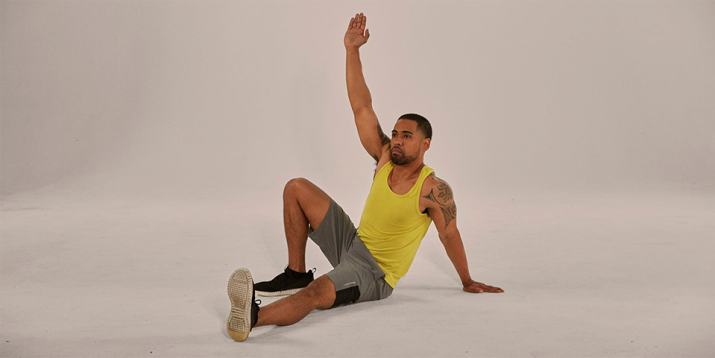How to Do the Sit-Through Exercise

At first glance, the sit-through exercise looks more like a breakdancing move than a strength-training exercise. It’s fun. It’s got flair. It requires agility and balance. And it’s not something you do to pack on tons of muscle. But after a couple of sets — as your heart rate begins to rise, as your breathing becomes faster, and as sweat starts to bead on your forehead — you’ll realize why the sit-through is a favorite of trainers everywhere: It packs one hell of a total-body punch.
Learn how to perform the bodyweight exercise with perform form in this demonstration from Megan Davies, creator of #mbf and #mbfa.
Sit-Through Exercise: Step-by-Step Instructions
- Assume a bear crawl position with your arms straight, your hands below your shoulders, and your knees bent 90 degrees below your hips. (Only your hands and toes should touch the ground.)
- Keeping your back flat, core braced, and right hand on the floor, lift your left arm and right leg, and rotate to your left, pivoting on your left foot as you thread your right leg beneath you and extend it straight on the floor. (You should now be sitting.)
- Reverse the movement to return to the starting position, and repeat to your other side, lifting your right hand and left leg, and pivoting on your right foot. Continue alternating sides.
Make it easier: Go slower.
Make it harder: Perform a “kick through,” keeping your leg and butt elevated off the floor. Want to make it even more challenging? Touch your toes with your opposite hand when you extend your leg — a move called the hip escape toe tap in CORE DE FORCE.
Bonus tip: Megan makes the sit-through exercise look easy, but it might take a few attempts before your mind and muscles synchronize their efforts. Go slowly at first — especially if you’ve never performed this exercise before — until the movement pattern becomes fluid.
Sit-Through Exercise Benefits
Here are the benefits you can expect from working sit-throughs into your workout routine.
1. Improves strength and stability
With the sit-through, you’ll almost immediately start feeling a burn in your shoulders and core as they work to stabilize your body. Your rectus abominis (a.k.a. your six-pack muscles), obliques, and even lower back must stay engaged to rotate your body and keep your trunk steady. And the strength and endurance of your shoulder muscles will be tested, as they bear your body weight throughout the entirety of the exercise.
Your leg muscles, like your glutes, quads, and hamstrings, also play a part in the sit-through, albeit to a lesser extent.
2. Increases mobility
“Side sit throughs are a fun way to incorporate hip rotation and functional mobility into a workout,” says Cody Braun, CSCS. The move requires significant rotation of the hips and torso, an aspect of fitness that’s often neglected with traditional strength training moves, which are mostly performed in one plane (either going forward and backward or side to side). So you’ll feel the benefits of finding strength in greater ranges of motion in other exercises and everyday life.
3. Builds coordination
The sit-through is a quite complex move that requires time to master. Not only are you coordinating the efforts of your upper and lower body, but you’re also continuously shifting weight from one side of your body to the other. As you learn to perform this exercise with greater dexterity, however, you’ll develop better balance and proprioception (a.k.a. body awareness).
